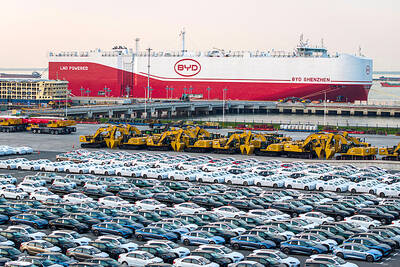By improving shuttle bus services and adding variety to the ticket, Taiwan High Speed Rail Corp (THSRC,
"Revenue for the entire year should reach NT$30 billion [US$929.5 million]. Our goal is to at least double the number of passengers," THSRC chief executive officer Ou Chin-der (歐晉德) said in a press conference celebrating the company's first year of operations yesterday.
Ou said that balance between monthly income and overhead would be attained by the end of this year.
In its first year, the company made revenues of NT$14 billion, with 15.79 million tickets sold.
The company said that its punctuality rate of 99 percent -- or delays averaging 0.27 minutes -- was better than that of Japan's Shinkansen, the Eurostar and the TGV in France.
Statistics released by the THSRC showed that the frequency of trains between Taipei and Kaohsiung had increased from 38 round trips in the first week of operation to 126 by the end of last year, with an average occupancy of 44.72 percent.
The company hopes to boost that percentage to 60 and the number of runs to 176 by December.
A survey by the Ministry of Transportation and Communications (MOTC) in September showed that 28.7 percent of occupants used the THSRC for business purposes, 26 percent to visit relatives, 22.7 percent for tourism, while 19.6 percent had only taken the train out of curiosity.
"Our aim is to win over people who still choose to drive their car on weekends or holidays and increase people's curiosity and confidence in the high-speed train," Ricardo Tan (
MOTC statistics showed that since the THSRC's first day of operation on Jan. 5 last year, passengers who took the airplane and traditional railways for trips within the country had both dropped by more than 10 percentage points, while those who took long-distance buses had declined 6 percent as of the end of September.
The percentage of people who choose to drive remained unchanged, at 21.4 percent.
In addition to plans to increase shuttle bus services at Taoyuan, Hsinchu, Chiayi and Tainan, and improvements in links to city centers in Taichung and Kaohsiung, the company intends to launch a multiple-entry pass this year, Ou said.
The first-come, first-served seating in selected compartments introduced in November as a pilot marketing scheme will become a regular service, he said.
Discounts for off-peak rides and package deals for small tourist groups are also on the drawing board, in a bid to widen the customer base and push up loading rates, Ou said.
Although the company was optimistic over its business prospects, Ou said that listing on the the Taiwan Stock Exchange remained a long-term goal.
THSRC trades on the Emerging Stock Market (
The company's shares closed 0.59 percent lower at NT$8.4 yesterday.
Ou said foreign investors had expressed an interest in offering new loans to THSRC to help reduce interest costs.
He declined to identify the interested parties.
The company's outstanding liability totaled NT$377.16 billion as of June 30, the company said.

Micron Memory Taiwan Co (台灣美光), a subsidiary of US memorychip maker Micron Technology Inc, has been granted a NT$4.7 billion (US$149.5 million) subsidy under the Ministry of Economic Affairs A+ Corporate Innovation and R&D Enhancement program, the ministry said yesterday. The US memorychip maker’s program aims to back the development of high-performance and high-bandwidth memory chips with a total budget of NT$11.75 billion, the ministry said. Aside from the government funding, Micron is to inject the remaining investment of NT$7.06 billion as the company applied to participate the government’s Global Innovation Partnership Program to deepen technology cooperation, a ministry official told the

Taiwan Semiconductor Manufacturing Co (TSMC, 台積電), the world’s leading advanced chipmaker, officially began volume production of its 2-nanometer chips in the fourth quarter of this year, according to a recent update on the company’s Web site. The low-key announcement confirms that TSMC, the go-to chipmaker for artificial intelligence (AI) hardware providers Nvidia Corp and iPhone maker Apple Inc, met its original roadmap for the next-generation technology. Production is currently centered at Fab 22 in Kaohsiung, utilizing the company’s first-generation nanosheet transistor technology. The new architecture achieves “full-node strides in performance and power consumption,” TSMC said. The company described the 2nm process as

Shares in Taiwan closed at a new high yesterday, the first trading day of the new year, as contract chipmaker Taiwan Semiconductor Manufacturing Co (TSMC, 台積電) continued to break records amid an artificial intelligence (AI) boom, dealers said. The TAIEX closed up 386.21 points, or 1.33 percent, at 29,349.81, with turnover totaling NT$648.844 billion (US$20.65 billion). “Judging from a stronger Taiwan dollar against the US dollar, I think foreign institutional investors returned from the holidays and brought funds into the local market,” Concord Securities Co (康和證券) analyst Kerry Huang (黃志祺) said. “Foreign investors just rebuilt their positions with TSMC as their top target,

POTENTIAL demand: Tesla’s chance of reclaiming its leadership in EVs seems uncertain, but breakthrough in full self-driving could help boost sales, an analyst said Chinese auto giant BYD Co (比亞迪) is poised to surpass Tesla Inc as the world’s biggest electric vehicle (EV) company in annual sales. The two groups are expected to soon publish their final figures for this year, and based on sales data so far this year, there is almost no chance the US company led by CEO Elon Musk would retain its leadership position. As of the end of last month, BYD, which also produces hybrid vehicles, had sold 2.07 million EVs. Tesla, for its part, had sold 1.22 million by the end of September. Tesla’s September figures included a one-time boost in